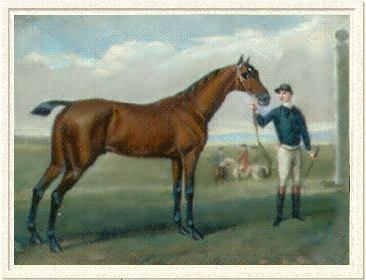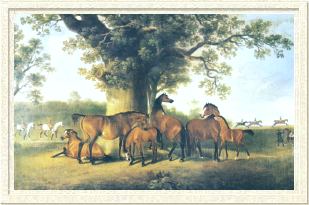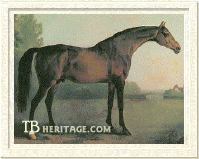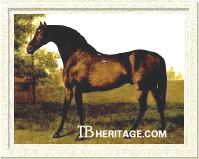|
|
Herod

|
|
 |
|
|
Foundation sires Herod and Eclipse were bred by the same man, William, the Duke of Cumberland, the third son of England's George II. Perhaps this is a nobler way to remember the man history remembers as "the Butcher of Culloden" after his military exploits against the Scots.
|

Cypron and her offspring: her tenth foal, Sejanus, is lying at her feet; Thais and the St. Quentin mare (with her colt Senlis) are next to her. Drone and Dunce are in exercise rugs in the background, and King Herod to the right, partially off the painting. | | The Duke of Cumberland's stud was located in Windsor Park, Berkshire, an operation spread over several estates, although the stallions and mares seem to have been headquartered at Cranbourne Lodge. It's here that his mare Cypron (b.f. 1750), bred by Sir W. St. Quintin, foaled a bay colt by the stallion Tartar in 1758. The colt was named King Herod and he proved a successful racehorse. He first started at the age of 5 years in 1763, in October, winning a race at Newmarket over the Beacon course of about 4 miles.
|
The next year, 1764, he won another purse at Newmarket, a four mile race at Ascot, and a match against Antinous over the Beacon course at Newmarket.
In 1765, his owner, the Duke of Cumberland died and his bloodstock dispersed. King Herod was sold to Sir John Moore and stayed in training. Also sold was a yearling colt by Marske out of Spiletta, sold to William Wildman for 75 guineas and named Eclipse.
In 1766, Herod returned to the races as an eight-year-old, and he proved victorious in a rematch with Antinous at Newmarket over the same course and distance. His career declined thereafter, losing to Ascham and later to Turf, and in August of that year, in a race at York, he bled and finished last. Kept in training, he returned to the races early in 1767, starting twice more, getting beaten at Newmarket by Bay Malton, but gaining retribution by defeating Ascham.
This was the end of his racing career, and Herod was retired to the stud of Sir John Moore at Neather Hall, close to Bury St. Edmunds in Suffolk, and only short way from Newmarket. He demanded a fee of 10 guineas. Apparently he covered part of the 1767 season, because his good son, Florizel, was foaled the following year.
|

Highflyer

Anvil | | Florizel (b.c. 1768) was an outstanding runner, wining 16 races from 23 starts. He was also a rousing success as a stallion, most importantly as the sire of Diomed, the winner of the first Derby and an overwhelmingly influential sire upon his arrival in America in his old age.
Woodpecker (ch.c. 1773) was the next major foal for Herod, a prolific winner and tremendous sire of Buzzard, Chanticleer, and Oaks winner Ephemera. Buzzard sired Selim, sire of Sultan, sire of Glencoe.
The next top horse by Herod was his most important, Highflyer (b.c. 1774), surely one for the ages as a runner and a sire. Highflyer was unbeaten in 14 races and was a leading sire in his own right, getting Sir Peter Teazle (in pedigrees as Sir Peter), Rockingham, Delpini, Escape, St. George, and the great broodmare Prunella among his many influential daughters.
Other significant runners and sires by Herod include Phoenomenon (St. Leger winner and leading sire), Justice (sire of Rhadamanathus, Daedalus, and Trifle), Weasel, Drone, Anvil, Fortitude (sire of John Bull), Telemachus, Fitzherod, and Bagot.
|
Herod's daughters produced important animals such as Waxy, Gohanna, Beningbrough, Coriander, Precipitate, Cereberus, imported Whip, Aimwell, Whiskey, Sergeant, and Dungannon. His daughters were crossed successfully with Eclipse and sons of Eclipse, and vice versa.
Herod was the leading sire in Great Britain eight times, from 1777 to 1784, at which point his son Highflyer took over and led as the sire of winners from 1785 to 1796 and again in 1798. Highflyer's son Sir Peter Teazle led from 1799 to 1802, and from 1804 to 1809.
Herod's sireline was the dominant sireline in Europe and America as well, where Diomed's line flourished through American Eclipse and Sir Archy, all the way down to the great American sire Lexington. Glencoe also hailed from the Herod male line through Woodpecker. The Herod sireline proved overwhelmingly dominant until the late Nineteenth Century, the end of which found the Lexington and Glencoe male lines dying out. This coincided with the rise of Eclipse's male line, which now dominates almost completely.
Herod was a well-made horse of great strength, speed, and gameness and excelled at the standard four mile distance. He was a solid bay with a small star above eye level and no white on his legs, a typical model for his sireline. Many descendants of the Byerly Turk were very dark in body color with few white markings. This conservative coloring is especially remarkable, since both of Herod's grandsires, Partner and Blaze, were blazed faced, with high stockings.
Herod continued to cover mares up until his death at Neather Hall on May 12, 1780, at the age of 22 years.
--Anne Peters
|
|
|
|

